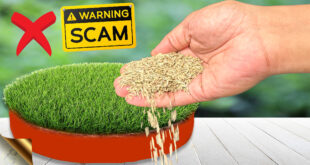In Today’s post, let’s learn step by step – how to easily, quickly and successfully perform smell free, aerobic composting at home with some very useful tips and tricks.
In our previous posts we discussed on the fundamentals of composting including Types of Composting, the Carbon Nitrogen ratio and demonstrated the anaerobic or bokashi composting method step by step.
In Today’s episode, let’s learn How to perfectly make compost at home in 5 easy steps:
Step 1: CHOOSING YOUR CONTAINER
There are many ways to compost. You can either use an open pile composting method or use a compost bin. Open pile composting or using a simple chicken mesh boundary is the simplest way to start, but it has its own disadvantages. The best way to compost at home is use a compost bin. Bins have the advantage of being neat, keeping animals, rodents and insects away and preserving heat. You can build your own DIY compost bin from some plastic buckets or even drums or barrels. You can even build a tumbling compost bin. Or you can just purchase these from a garden store or online. The size and type of bin you build or purchase will depend on how much compostable material you generate on a day to day basis. A rotating Tumbler compost bin has many advantages, like you need not turn up the compost pile for oxygenation manually, instead you just give few rotations once daily and this will also speed up the composting process. The twin drum has an advantage of providing continuous supply of compost, like when one drum is full, you leave it for few weeks for final maturation and then start adding materials in the second bin. And repeat this process to get a continuous supply of compost.
PURCHASE TUMBLER BINS HERE:
Twin Tumbler Compost Bin https://amzn.to/3960iyp
Single Tumbler Compost https://amzn.to/2CL4ibs
Step 2: CHOOSING THE LOCATION
For conventional pile composting, a sunny location and a flat surface on soil is better. For drum composting or if using a tumbling composter this is not so crucial. However keep in a place which is open with good air circulation, and also keep in mind there is a liquid leak below the compost bins. This compost tea can be collected and makes a good liquid fertilizer for plants if used in adequate dilution.
Step 3: ADDING GREENS AND BROWNS
This we have discussed in detail in part 2 of our composting series. For greens and kitchen waste recycling you can add them daily to your compost bin along with browns. If your daily collection is too little, you can store in refrigerator and then add to your bin. Greens are nitrogen rich and mostly wet materials like waste kitchen scraps like vegetables scraps, fruit scraps, fresh grass cuttings, animal manure but not your cat or dog poop, then bird or poultry droppings, feathers, fleshy plants and leaves, flowers, tea and coffee waste, egg shells, nail clippings, human and animal hair, and so on.
Browns are carbon rich dry materials like dry fallen leaves, dried flowers, wood chips, twigs, straw, shredded paper, shredded card board or paper cartons, and also the toilet paper rolls, toilet paper or used napkins or facial tissues, coffee filters and tea bags, cotton, sawdust, pine needles, Pencil Shavings, dried grass clippings, peat moss, cocopeat or coconut fibers, used paper plates, nut shells, wine corks, toothpicks, paper cupcakes, used match sticks, wood ash or ashes from the fireplace, coal, and so on.
Well, We will not go into discussing the Carbon : Nitrogen Ratio in this episode. You just have to remember the Green to Brown Ratio while adding stuff into compost bin.
As a General Rule: A 1-to-1 Ratio works well with the Add as You Go Pile as well as for the Batch Pile and is safe for beginners. This will aid you in creating about a 50:1 C/N Ratio, adequate enough to get a warm pile. This means, For every bowl of greens, you add one bowl of browns and a little bit of compost activator.
Step 4: COMPOST STARTER or ACCELERATOR OR ACTIVATOR
If you are starting for the first time or first batch, you need to add those microorgansisms to start the composting process. This can be either a commercial compost maker powder; but remember not to add the Bokashi bran powder which is exclusively meant for anaerobic composting which we have discussed and demonstrated in detail in episode 3 of this composting series. You can check that link in description below. So, you can add this powder like 1 or 2 teaspoons or as recommended in your packet and, every time you add greens and browns and then rotate the tumbler or turn your compost a few times for good oxygenation. If you have a half finished compost or even a fully finished compost or decomposed cowdung can be added as a starter. You can also add the finished compost from your Bokashi bucket into this aerobic compost bin.
Step 5: MATURATION AND HARVESTING
when the bin is 70 to 80% full, stop adding further waste into it and leave it for 6 to 8 weeks for compost cooking and final maturation. But make sure you tumble the compost bin on a daily basis or if you are doing the compost pile method, you need to turn the compost pile every other day for proper aeration, otherwise it will develop foul smell and fail. If you are getting a sweeter pleasant smell, then everything is going fine. After 6 to 8 weeks or even more, you can collect your final compost and use this pure fertilizer for your plants. You can leave about 10% in the bin which acts as an accelerator for the next batch. Finished compost will be dark, crumbly and smell like earth.
 GKVKs – Gardening Tips and Store Gardening Tips and Store
GKVKs – Gardening Tips and Store Gardening Tips and Store



